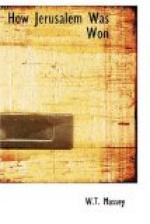When the 75th Division were making the attack on Nebi Samwil the 52nd Division put all the men they could spare on to the task of making roads. To be out of the firing line did not mean rest. In fact, as far as physical exertion went, it was easier to be fighting than in reserve. From sunrise till dark and often later the roadmakers were at work with pick, shovel, and crowbar, and the tools were not too many for the job. The gunners joined in the work and managed to take their batteries over the roads long before they were considered suitable for other wheels. The battery commanders sometimes selected firing positions which appeared quite inaccessible to any one save a mountain climber, but the guns got there and earned much credit for their teams.
On the 22nd Nebi Samwil was thrice attacked. British and Indian troops were holding the hill, but the Turks were on the northern slopes. They were, in fact, on strong positions on three sides, and from El Burj, a prominent hill 1200 yards to the south-east, and from the wooded valley of the wadi Hannina, they could advance with plenty of cover. There was much dead ground, stone walls enclosed small patches of cultivation, and when troops halted under the terraces on the slopes no gun or rifle fire could reach them. The enemy could thus get quite close to our positions before we could deal with them, and their attacks were also favoured by an intense volume of artillery fire from 5.9’s placed about the Jerusalem-Nablus road and, as some people in Jerusalem afterwards told me, from the Mount of Olives. The attackers possessed the advantage that our guns could not concentrate on them while the attack was preparing, and could only put in a torrent of fire when the enemy infantry were getting near their goal. These three attacks were delivered with the utmost ferocity, and were pressed home each time with determination. But the 75th Division held on with a stubbornness which was beyond praise, and the harder the Turk tried to reach the summit the tighter became the defence. Each attack was repulsed with very heavy losses, and after his third failure the enemy did not put in his infantry again that day.
The 75th Division endeavoured to reach El Jib, a village on the hill a mile and a half to the north of Nebi Samwil. The possession of El Jib by us would have attracted some of the enemy opposing the advance of the Yeomanry Mounted Division on the left, but not only was the position strongly defended in the village and on the high ground on the north and north-west, but our infantry could not break down the opposition behind the sangars and boulders on the northern side of Nebi Samwil. The attack had to be given up, but we made some progress in this mountainous sector, as the 52nd Division had pushed out from Dukku to Beit Izza, between 3000 and 4000 yards from El Jib, and by driving the enemy from this strong village they made it more comfortable for the troops in Biddu




